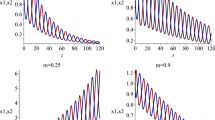Abstract
In this article, a structured metapopulation model in discrete time with catastrophes and density-dependent local growth is introduced. The fitness of a rare mutant in an environment set by the resident is defined, and an efficient method to calculate fitness is presented. With this fitness measure evolutionary analysis of this model becomes feasible. This article concentrates on the evolution of dispersal. The effect of catastrophes, dispersal cost, and local dynamics on the evolution of dispersal is investigated. It is proved that without catastrophes, if all population–dynamical attractors are fixed points, there will be selection for no dispersal. A new mechanism for evolutionary branching is also found: Even though local population sizes approach fixed points, catastrophes can cause enough temporal variability, so that evolutionary branching becomes possible.
Similar content being viewed by others
References
Christiansen, F.B., 1991. On conditions for evolutionary stability for a continuously varying character. Am. Nat. 138, 37–50.
Clobert, J., Danchin, E., Dhondt, A.A., Nichols, J.D. (Eds.), 2001. Dispersal. Oxford University Press.
Comins, H.N., Hamilton, W.D., May, R.M., 1980. Evolutionarily stable dispersal strategies. J. Theor. Biol. 82, 205–230.
Dieckmann, U., Law, R., 1996. The Dynamical Theory of Coevolution: A Derivation from Stochastic Ecological Processes. J. Math. Biol. 34, 579–612.
Doebeli, M., 1995. Dispersal and dynamics. Theor. Popul. Biol. 47, 82–106.
Doebeli, M., Ruxton, G.D., 1997. Evolution of dispersal rates in metapopulation models: Branching and cyclic dynamics in phenotype space. Evolution 51, 1730–1741.
Eshel, I., 1983. Evolutionary and continuous stability. J. Theor. Biol. 103, 99–111.
Gandon, S., 1999. Kin competition, the cost of inbreeding and the evolution of dispersal. J. Theor. Biol. 200, 245–364.
Gandon, S., Michalakis, Y., 1999. Evolutionarily stable dispersal rate in a metapopulation with extinctions and kin competition. J. Theor. Biol. 199, 275–290.
Geritz, S.A.H., Kisdi,É. Meszéna, G., Metz, J.A. J., 1998. Evolutionarily singular strategies and the adaptive growth and branching of the evolutionary tree. Evol. Ecol. 12, 35–57.
Geritz, S.A.H., Metz, J.A.J., É. Kisdi, Meszéna, G., 1997. Dynamics of adaptation and evolutionary branching. Phys. Rev. Lett. 78, 2024–2027.
Geritz, S.A.H., van der Meijden, E., Metz, J.A.J., 1999. Evolutionary dynamics of seed size and seedling competitive ability. Theor. Popul. Biol. 55, 324–343.
Gyllenberg, M., Metz, J.A.J., 2001. On fitness in structured metapopulations. J. Math. Biol. 43, 545–560.
Gyllenberg, M., Parvinen, K., 2001. Necessary and sufficient conditions for evolutionary suicide. Bull. Math. Biol. 63, 981–993.
Gyllenberg, M., Parvinen, K., Dieckmann, U., 2002. Evolutionary suicide and evolution of dispersal in structured metapopulations. J. Math. Biol. 45, 79–105.
Hastings, A., 1983. Can spatial variation alone lead to selection for dispersal. Theor. Pop. biol. 24, 244–251.
Heino, M., Hanski, I., 2001. Evolution of migration rate in a spatially realistic metapopulation model. Am. Nat. 157, 495–511.
Holt, R.D., McPeek, M., 1996. Chaotic population dynamics favors the evolution of dispersal. Am. Nat. 148, 709–718.
Johst, K., Doebeli, M., Brandl, R., 1999. Evolution of complex dynamics in spatially structured populations. Proc. R. Soc. London B 266, 1147–1154.
Kisdi, É., 2002. Dispersal: Risk spreading versus local adaptation. Am. Nat. 159, 579–596.
Levins, R., 1969. Some demographic and genetic consequenses of environmental heterogeneity for biological control. Bull. Entomol. Soc. Am. 15, 237–240.
Levins, R., 1970. Extinction. In: Gerstenhaber, M. (Ed.), Some Mathematical Problems in Biology. American Mathematical Society, Providence, RI, pp. 77–107.
Mathias, A., É. Kisdi, Olivieri, I., 2001. Divergent evolution of dispersal in a heterogeneous landscape. Evolution 55, 246–259.
Matsuda, H., 1985. Evolutionarily stable strategies for predator switching. J. Theor. Biol 115, 351–366.
Maynard Smith, J., 1976. Evolution and the Theory of Games. Am. Sci. 64, 41–45.
Maynard Smith, J., Price, G.R., 1973. The logic of animal conflict. Nature 246, 15–18.
McPeek, M., Holt, R.D., 1992. The evolution of dispersal in spatially and temporally varying environments. Am. Nat. 140, 1010–1027.
Meszéna, G., Czibula, I., Geritz, S.A.H., 1997. Adaptive dynamics in a 2-patch environment: a toy model for allopatric and parapatric speciation. J. Biol. Syst. 5, 265–284.
Meszéna, G., Czibula, I., Geritz, S.A.H., 1997. Adaptive dynamics in a 2-patch environment: a toy model for allopatric and parapatric speciation. J. Biol. Syst. 5, 265–284.
Metz, J.A.J., Gyllenberg, M., 2001. How should we define fitness in structured metapopulation models? Including an application to the calculation of ES dispersal strategies. Proc. R. Soc. London B 268, 499–508.
Metz, J.A.J., Nisbet, R.M., Geritz, S.A.H., 1992. How should we define “fitness” for general ecological scenarios? Trends Ecol. Evol. 7, 198–202.
Metz, J.A.J., Nisbet, R.M., Geritz, S.A.H., 1992. How should we define “fitness” for general ecological scenarios? Trends Ecol. Evol. 7, 198–202.
Parvinen, K., 1999. Evolution of migration in a metapopulation. Bull. Math. Biol. 61, 531–550.
Parvinen, K., 2001. Adaptive Metapopulation Dynamics . Ph.D. thesis, University of Turku, Finland.
Parvinen, K., 2001. Adaptive Metapopulation Dynamics . Ph.D. thesis, University of Turku, Finland.
Parvinen, K., Dieckmann, U., Gyllenberg, M., Metz, J.A.J., 2003. Evolution of dispersal in metapopulations with local density dependence and demographic stochasticity. J. Evol. Biol 16, 143–153.
Parvinen, K., 2005. Evolutionary suicide. Acta Biotheoretica 53, 241–264.
Parvinen, K., 2005. Evolutionary suicide. Acta Biotheoretica 53, 241–264.
Taylor, P.D., 1989. Evolutionary stability in one-parameter models under weak selection. Theor. Popul. Biol. 36, 125–143.
Van Tienderen , P.H., De Jong, G., 1986. Sex ratio under the haystack model: Polymorphism may occur. J. Theor. Biol. 122, 69–81.
Van Tienderen , P.H., De Jong, G., 1986. Sex ratio under the haystack model: Polymorphism may occur. J. Theor. Biol. 122, 69–81.
Van Valen, L., 1971. Group selection and the evolution of dispersal. Evolution 25, 591–598.
Author information
Authors and Affiliations
Corresponding author
Rights and permissions
About this article
Cite this article
Parvinen, K. Evolution of Dispersal in a Structured Metapopulation Model in Discrete Time. Bull. Math. Biol. 68, 655–678 (2006). https://doi.org/10.1007/s11538-005-9040-1
Received:
Accepted:
Published:
Issue Date:
DOI: https://doi.org/10.1007/s11538-005-9040-1



